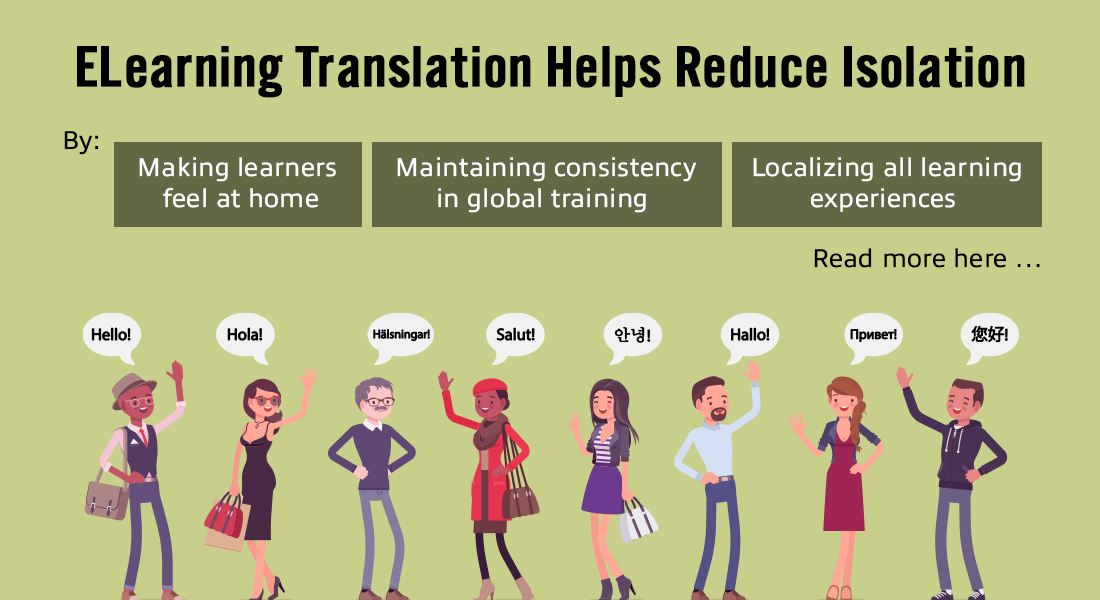Reduce Remote Learner Isolation through eLearning Translations

Growing businesses entail an ever-growing employee base; and with that comes the challenge of training a geographically dispersed workforce. The ongoing COVID-19 crisis has put paid (at least for now) to any thoughts of organizing classroom training for your remote workforce. So, you need to train your remote and dispersed workforce virtually. With that comes the question, “How do I prevent learners feeling isolated?” The answer? eLearning translation that has turned out to be the solution in this situation.
E-learning Translation: Perfect to Minimize Learner Isolation
- Translating to native languages makes learners feel at home.
- Translating one master course to multiple languages maintains global training consistency.
- Translation eases learner understanding.
- Translation provides learners with contextual and relatable skill sets for real-time use.
But what is it about eLearning translation that I’m writing an entire blog on it? Could it not be done with Google Translate? To answer that question, it is both yes and no. Let me explain. When you translate a sentence from English to any other language, you get the verbatim meaning. That is exactly what Google Translate does – verbatim translation. But what about the context and the semantics? Aren’t they important considerations? Definitely!
Check out this webinar to learn how you can leverage instructional design strategies to make learners remember.
Literal translation of an eLearning course can be counterproductive, as it only converts the words from the source to the target language and does not provide the exact contextual meaning from the source language. The cultural nuances also have to be considered. Unfortunately, no automated translator exists in the public domain which can decode and translate a text with its full contextual meaning intact. Besides, when it comes to remote training, mere eLearning translation is not enough; your courses need to be localized too.
Localization refers to the process of addressing the cultural and linguistic issues of a particular geographic location. E-learning translation not only provides the translation of words, it also takes care of the cultural barriers that jam efficient training, bringing all employees on the same platform and providing them the same quality training wherever they may be.
4 Reasons Why eLearning Translation Reduces Isolation
Although the benefits of eLearning translation mostly involve the range of business opportunities and global outreach it provides companies, we often tend to side-line the learners’ side of the story. Let us turn the coin and see why eLearning translation helps global learners overcome remote training isolation due to language barriers.
1. Translation Makes Learners Feel More at Home
Making the training content available in the learners’ native languages ensures they do not feel isolated while taking the course. That is because they are more comfortable with their own native language and also do not have to struggle with the subtle nuances of the English language, or any other foreign language in which the course was initially created.
As much as translation is critical for global remote training, a lot of the complexities in the process are dependent on the linguistic features of the source language. Therefore, I suggest you keep the following best practices in mind while translating.
Avoid using phrases and idioms in the source language – Ensure that your source course does not have too many phrases, idioms, or colloquialisms in the source language. Phrases and idioms may not have a meaningful counterpart in the target language, making it difficult for the learners to fully understand.
Avoid colloquial anecdotes and examples – Colloquial anecdotes and examples hold culturally and socially relevant contexts which may not resonate well with the learners, and in cases can even be unintentionally offensive. This increases learner isolation.
Stick to concise learning content – While translating, the vocabulary and syntax of the target language alters the length and meaning of the sentences. Redundancies can therefore be an added burden for the translators as well as the target learners. Ensure that there is ample white space in the slides so that the expanding text size can be adjusted.
Do not use text in images –Texts which have been embedded in an image format, is very hard to translate and can delay the translation process. Besides, having two different languages in a training slide is also a big visual turn off. Refrain from using texts in image format.
2. Translation of One Master Course Maintains Training Consistency
When you are training a global workforce, you do not have absolute control over when and what quality of training the learners will be receiving. It is quite possible for technical inaccuracies to come through. Therefore, having a master course that is built in simple language, has no redundancies, has accurate content, and a neutral visual design, keeps cross-country training consistent.
Wondering how that helps with isolation? Think about this, if you knew that your colleagues from Portugal, Japan and UAE are learning the same thing, only in their native languages, you would hardly feel left out. Therefore, in addition to saving a pretty penny, translation also minimizes the feeling of alienation while fostering interconnectedness amongst your dispersed workforce.
3. Translation Takes Care of Learners’ Ease of Understanding and Training
Employees will have an increased loyalty toward the organization if they know that their employers are going to lengths to make their learning experience better. One sure shot way to achieve that is to localize the entire learning experience. That means not only the text, but rather all audio-visual elements, graphics and illustrations, interactivities and games will also be localized whenever and wherever required. Here’s a handy list of things you can do:
- Scenarios might sometimes need to be localized according to the host country.
- Games and in-course graphic elements are normally kept neutral to not appeal to any particular cultural norms. However, they too can be changed to something more specific if needed.
- In many countries and regions, even a common hand gesture like the ‘thumbs up’, is considered rude and offensive. Therefore, it is important to check different icons, colors, and graphic elements for appropriateness.
4. Translation Provides Learners With Contextual and Relatable Skill Sets
Translating eLearning courses not only increases content comprehension for the target audience, it also opens up new channels of communication which can be later utilized for improving overall business opportunities. Through eLearning translation, important training requirements can be clearly explained to remote learners.
For instance, in sales training, different communication skills like negotiation, persuasion and soft-skills can be trained in their native language, under localized contexts/scenarios. Equipped with the sales knowledge, and propelled by the ability to flawlessly communicate in their native languages, learners can put the training to immediate use, thus increasing overall business opportunities for the company, while also honing their individual skills.
Wrapping it Up!
So now you see, why eLearning translation is important. It does not matter if you have studied Spanish in junior high. You will still be comfortable learning in English (assuming English is your native tongue), as well as implementing what you have learned, in English. It just feels closer to home doesn’t it?
That is the whole point of eLearning translations – making your learners feel close to home and not isolated. This is why mere verbatim translation of courses is not enough, and almost always needs to be associated with localization of elements within the course to make it look and feel near native to the learner. The stronger the learner is connected to the course, the less isolated they feel. E-learning translation thus becomes a guaranteed way to achieve that.
Starting out with eLearning? This game changing eBook on the ‘basics of eLearning’ is just what you need. Download Now!




![Reduce Learners’ Isolation through Translation – Check How [SlideShare]](https://blog.commlabindia.com/hubfs/Imported_Blog_Media/elearning-translation-reduce-learner-isolation.jpg)
